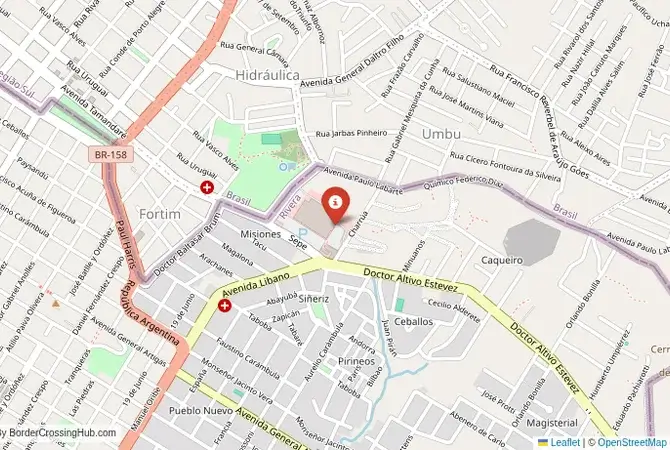
Approximate Border Location
Wait Times
15-30 min for pedestrians/vehicles
Operating Hours
Open 24 hours
Crossing Types
Pedestrians, vehicles
Border Type
Land crossing via road
Peak Times
Mornings (8-11 AM), weekends
Daily Crossings
~10000 travelers/vehicles
Currency Exchange
Available near Santana (BRL, UYU)
Safety Information
Generally safe, open border
Languages Spoken
Portuguese, Spanish
Accessibility Features
Ramps, elevators
About Rivera & Santana do Livramento
The “Frontier of Peace”
The border crossing connecting the Brazilian city of Santana do Livramento with Rivera in Uruguay is one of the most iconic and deeply integrated “twin city” frontiers in the world. This is not a bridge over a river or a formal checkpoint on a highway; it is an open, urban border where a shared central park, the Parque Internacional, is the only thing separating two nations. To cross here is to simply walk from one side of a plaza to another. This “Fronteira da Paz” (Frontier of Peace) is a bustling hub of commerce, a place where two cultures and languages blend into a unique border identity known as “Portuñol.” It is a seamless passage that is a powerful symbol of the close and historic relationship between Brazil and Uruguay.
Operational Details
This checkpoint connects Brazil’s Rio Grande do Sul state with the Rivera Department of Uruguay. There is no single, mandatory checkpoint for moving between the city centers. People cross freely for shopping, work, and daily life. However, formal immigration offices exist on both sides for travelers who need to officially enter or exit the country—a crucial step for anyone not just visiting for the day. The Brazilian Federal Police office is located in Santana do Livramento, while the Uruguayan Dirección Nacional de Migración has an office in Rivera. For commercial freight, there are dedicated customs terminals on the outskirts of the cities. The border is, for all intents and purposes, open 24/7 for local movement.
Before Crossing
Crossing borders gets messy sometimes, think political flare-ups or gates shutting fast. Good travel insurance is a must for handling doctor visits, trip disruptions, or security scares. Don’t get caught unprepared. To find a policy that’s got your back, check out reliable plans today for peace of mind.
A History of a Gaúcho Heartland
The history of this region is the history of the Pampa, the vast grasslands that are the heartland of the Gaúcho (Gaucho in Spanish) culture. This has been a land of cattle ranching and a contested frontier between the Spanish and Portuguese empires for centuries. The modern border was established in the 19th century, but the shared Gaúcho culture, with its traditions of horsemanship, barbecue (churrasco/asado), and mate (chimarrão/mate), has always transcended the political line. The two cities grew up together, their fortunes intertwined. The creation of the Parque Internacional in 1943, with its obelisk marking the border, was a powerful statement of the desire for peaceful coexistence and integration.
The Unique Border Procedure
The border crossing procedure is unique. For a day trip of shopping in Rivera, most Brazilian and Uruguayan citizens simply cross without any checks. However, for foreign tourists or for anyone planning to travel further into either country, it is absolutely essential to seek out the immigration offices and get the proper entry and exit stamps. Failure to do so can result in significant fines and legal problems when you try to leave the country from another point. For example, a tourist driving from Brazil to Montevideo must stop in Rivera to get a Uruguayan entry stamp. The open nature of the border can be deceptive; the formal requirements are still very much in place for international travelers.
The Surrounding Region: Brazil Side
On the Brazilian side, Santana do Livramento is a major center of the “Campanha Gaúcha,” the Brazilian pampas. The city is known for its sheep and cattle ranching and is increasingly a center for high-quality wine production, with several award-winning wineries in the area. The city has a charming, historic atmosphere. The main attraction for many visitors is the city’s role as a gateway to the duty-free shopping in Rivera.
The Surrounding Region: Uruguay Side
On the Uruguayan side, Rivera is a bustling commercial center. The main street, Avenida Sarandí, is lined with duty-free shops (“free shops”) selling a wide range of goods, from perfumes and electronics to clothing and spirits. It is a major shopping destination for Brazilians from all over the state of Rio Grande do Sul. The city also has a number of casinos. The surrounding Rivera department is a beautiful region of rolling hills and vineyards, part of Uruguay’s growing wine country.
Practical Travel Information
Practical planning is essential. Remember to get your passport stamped if you are traveling further into either country. The official currencies are the Brazilian Real (BRL) in Brazil and the Uruguayan Peso (UYU) in Uruguay, but the US Dollar is widely used and accepted in the duty-free shops of Rivera, and the Brazilian Real is often accepted as well. The unique language of the border is “Portuñol,” a mix of Portuguese and Spanish. Be aware of the customs limits for goods you can bring back into Brazil. Vehicle insurance (Carta Verde) is mandatory for driving between the two countries.
Final Considerations
The Santana do Livramento–Rivera border crossing is a fascinating and complex place. It is a symbol of the deep economic and cultural integration between Brazil and Uruguay, and a testament to the unique character of a truly open border. It is a bustling, vibrant hub of commerce, a place that is both a shopper’s paradise and a living museum of Gaúcho culture. For the traveler, it offers a unique cultural experience, a glimpse into a world where two nations merge into one dynamic and unforgettable “Frontier of Peace.”
No reviews yet.
